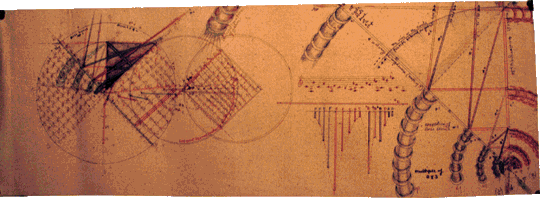
THE FIRST CYCLE MIGHT END IN A DISINTEGRATION
The first or base cycle is shown visually and
musically in the detail to the right. Where a note's ratio to C is indicated a
line representing the color assigned to the note is drawn. A series of zig zags
take form. The red tubes representing the sixth dimension of space stand for the
side of a triangle. The green tubes are always the hypotenuse of a triangle.
Since the proportions of F to C are in the relation to one another as 1:1 is to
3:4, as is clearly seen, the hypotenuse is always extending at a faster rate,
and of greater length than the side.
Musically this can be heard by sounding the C and the F frequently. The
relative proportions of the other notes are indicated as unit measurements.
Their actual proportions would be the inverse of what is shown, but it makes it
easier to understand when reduced to units of one.
The reason the cycle
ends at 64 as the side of the triangle and at 243 as the hypotenuse, is that the
limit of 243 and 256 appears to be limited in terms of finding a ratio 729/n.
The nearest ratio is 729/640. 100 x 64 indicates that another measuring rod must
be used at this stage.
In the base unit, the measuring rod is 2 on the side
---- 3 on the hypotenuse... The drawing on the left shows how both series plus
and minus (sharped or flatted) overlap on series 1, adding a visual confusion.
The grid shows how one can determine a unit measurement, by extending a line to
its multiple, thus determining length proportionally and angle.
At the
point where angles cross, one can establish a beginning place for another
series.